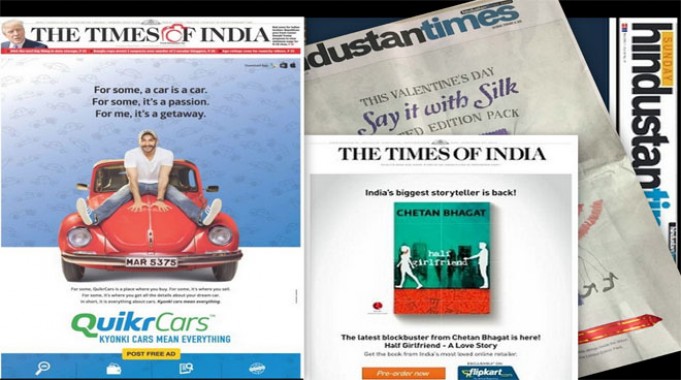Hijacking the front page
OUT OF PRINT
Binoo K John
With jacket ads becoming increasingly popular as a platform of advertising, there is danger of page one disappearing forever. Almost all national newspapers now accept jackets which come in place of page one. On Independence Day eve and on August 18, the Times of India had four pages of these ads with the result that page one of the paper started at page 5.
The advantage to the advertiser is huge since it appears along with the masthead, confusing the reader as to whether it is an advertorial, some editorial gimmick or an advertisement itself. Since it is not the start of the editorial section, such jacket insertions should ideally appear without the masthead. The masthead should appear only on the page in which the editorial starts.
On a day when there is a big story, it becomes a bit embarrassing for a newspaper to have an Amitabh Bachchan endorsement on page one, an Amazon ad on page two, and page one actually starting on page 3 or on page 5. Regular full page ads do not have the benefit of the masthead to endorse or ad credibility to the product.
The editorial, in fact, is offering its credibility and the weight of the paper’s reputation by lending the masthead to a page where there is no news. If such wraparound ads appear without the masthead, it has little value to the advertiser.
The jacket advertiser has to book at least two full pages plus pay extra for the privilege of being page one of the day. This is because page two is a left hand page and the actual edit page cannot appear on the left hand side.
It is the costliest page in print advertising. Though journalists might crib about the loss of editorial sanctity, ad managers guffaw all the way to the bank. The Time of India can net something in the range of Rs 1.5 crore for a jacket appearing in all editions. Smaller papers like DNA can expect to get Rs 5-8 lakh (for a jacket in a single edition.)
Increasingly, editorial space is being swallowed by advertisers and their gimmicks. Page one, apart from being the first page that the reader sees, also has various connotations for the reporters. A reporter who has filed the exclusive page one story is reduced to saying “My story was on page one, sorry er, page five. ”
Newspapers struggling to increase revenue have no option but to listen to the diktats of the advertiser. Innovative ads now appear with the news stories text-wrapped around them and pages designed with stories supporting the product. The Hindustan Times too is a player in this exclusive segment. The Times of India evenallows advertisers to play around with its own masthead which was once considered sacrosanct.
As old formats of news delivery change drastically, these are games which the traditional media has to resort to as a survival tactic. I haven’t seen this phenomenon in British or US newspapers where I guess the sense of sanctity about page one is still preserved. Perhaps because those papers can afford to preserve it. Newspaper readers there pay much more for their daily copy than we Indians do.
Everything points to page one in the major newspapers being sold out permanently to advertisers. Most such advertisers are new players, mostly technology firms who have tons of cash. But for print journalists, it is yet another indication of their increasing irrelevance.
* * * * *
From global to local at the Hindu
The content changes happening in the Hindu are interesting to watch. I have already commented on the Sunday magazine’s neat new look. Most interesting, however, are the content changes with micro-coverage of local events getting a full page in the Delhi edition. The paper scoffed at local coverage for a long time and took pride in the fact that it had reporters stationed in important corners of the world and could bring in stories that no other paper could. It was the paper that helped government ‘decide’ policy. That pretension has rightly been given up.
The Hindu has started a series on how Swachh Bharat is doing and has come up with the pictures of squalor on Delhi streets. I guess each edition has its own page for such drain inspectors reports. In the Delhi edition, Vox Pop gets the usual play and there is an interesting interview with a cleaner who says he cleans all the shit, even human excreta, in Janakpuri district centre market but is not allowed to use the toilet there. That caste distinctions still work here is no surprise. That is why Mayawati scoffed at Swachh Bharat, calling it a ploy to keep dalits busy cleaning the roads for the other castes.
The Hindu has done well by trying to micro-localize its edition. How far it can outgun the leaders – Hindustan Times and Times of India - in this game is difficult to predict because it will require more reporters to cover the civic beat. Will the Hindu ever lead with a Delhi civic story (‘Stray dog menace in Delhi’) like the TOI and HT? That would call for drastic change in the way the paper is positioned.







